CHEVROLET CAVALIER 1995 3.G Owners Manual
Manufacturer: CHEVROLET, Model Year: 1995, Model line: CAVALIER, Model: CHEVROLET CAVALIER 1995 3.GPages: 340, PDF Size: 17.09 MB
Page 301 of 340
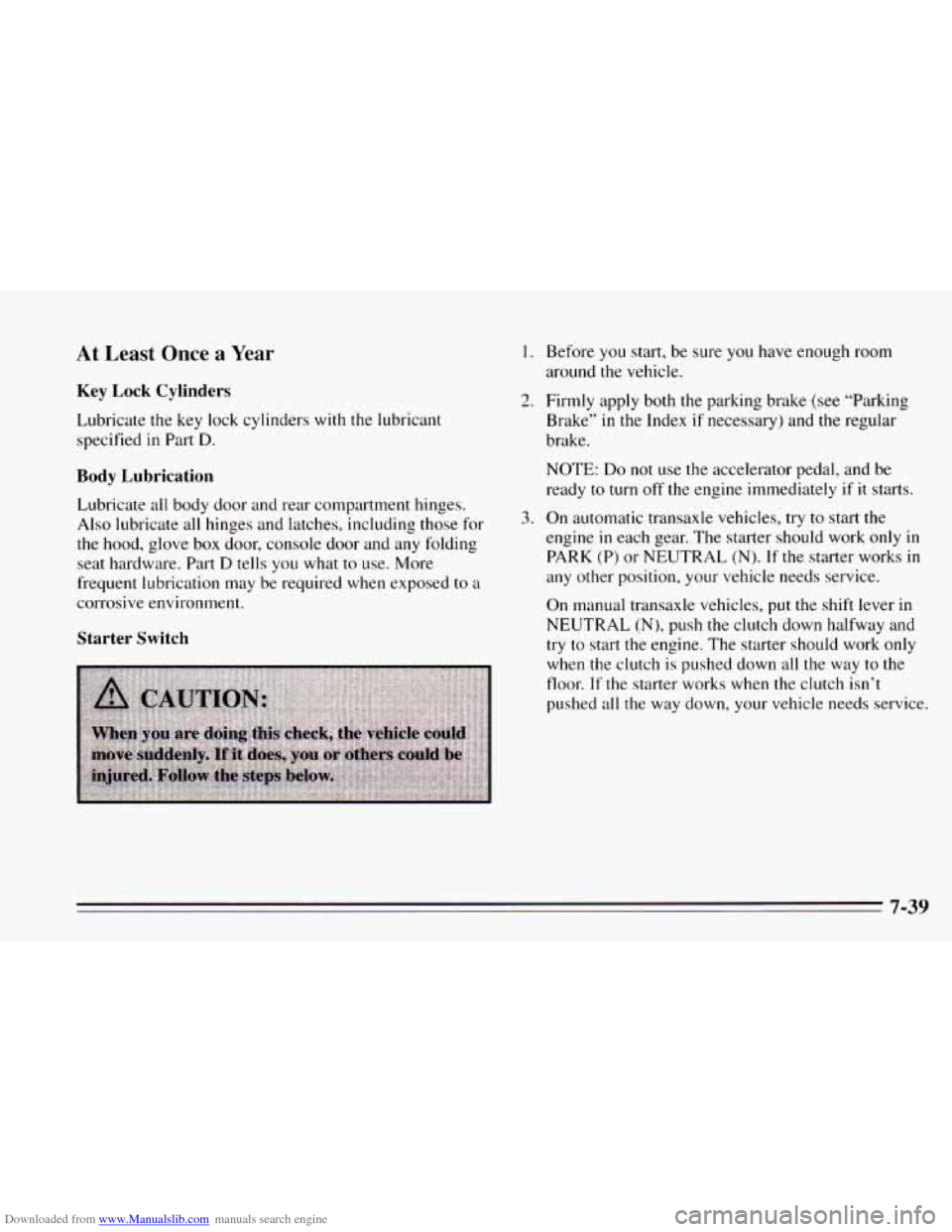
Downloaded from www.Manualslib.com manuals search engine At Least Once a Year
Key Lock Cylinders
Lubricate the key lock cylinders with the lubricant
specified
in Part D.
Body Lubrication
Lubricate all body door and rear compartment hinges.
Also lubricate all hinges and latches, including those for
the hood, glove box door, console door and any folding
seat hardware. Part
D tells you what to use. More
frequent lubrication may be required when exposed
to a
corrosive envlronment.
Starter Switch
1. Before you start, be sure you have enough room
around the vehicle.
2. Firmly apply both the parking brake (see “Parking
Brake”
in the Index if necessary) and the regular
brake.
NOTE:
Do not use the accelerator pedal, and be
ready
to turn off the engine immediately if it starts.
3. On automatic transaxle vehicles, try to start the
engine
in each gear. The starter should work only in
PARK (P) or NEUTRAL (N). If the starter works in
any other position, your vehicle needs service.
On manual transaxle vehicles, put the shift lever in
NEUTRAL
(N), push the clutch down halfway and
try to start the engine.
The starter should work only
when the clutch is pushed down all the way
to the
floor. If the starter works when the clutch isn’t
pushed
all the way down, your vehicle needs service.
7-39
Page 302 of 340
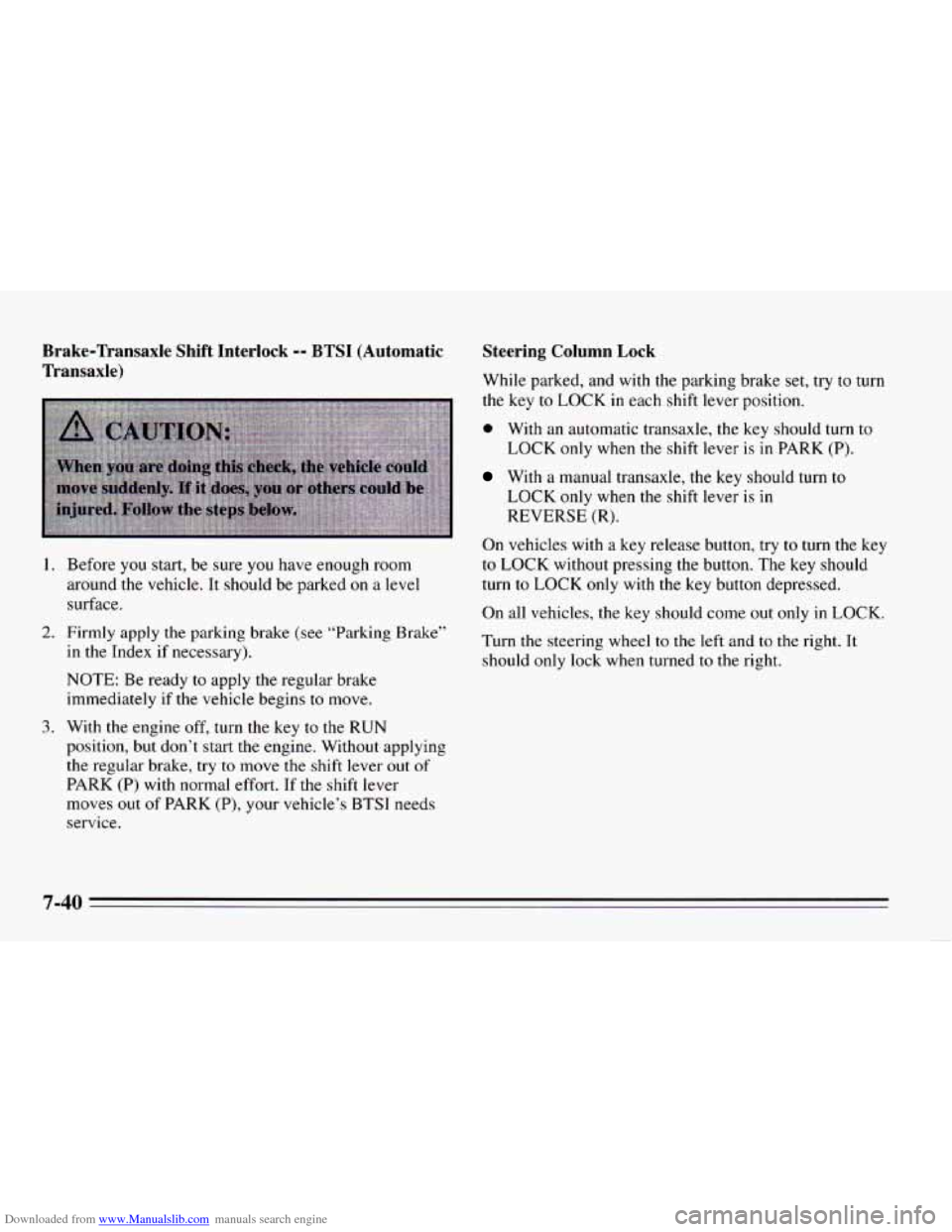
Downloaded from www.Manualslib.com manuals search engine Brake-Transaxle Shift Interlock -- BTSI (Automatic
Transaxle)
1.
2.
3.
Before you start, be sure you have enough room
around the vehicle. It should be parked
on a level
surface.
Firmly apply the parking brake (see “Parking Brake”
in the Index
if necessary).
NOTE: Be ready to apply the regular brake
immediately
if the vehicle begins to move.
With the engine off, turn the key to the RUN
position, but don’t start the engine. Without applying
the regular brake, try
to move the shift lever out of
PARK (P) with normal effort, If the shift lever
moves
out of PARK (P), your vehicle’s BTSI needs
service.
Steering Column Lock
While parked, and with the parking brake set, try to turn
the key to
LOCK in each shift lever position.
0 With an automatic transaxle, the key should turn to
LOCK only when the shift lever
is in PARK (P).
With a manual transaxle, the key should turn to
LOCK only when the shift lever is in
REVERSE
(R).
On vehicles with a key release button, try to turn the key
to LOCK without pressing the button. The key should
turn to
LOCK only with the key button depressed.
On all vehicles, the
key should come out only in LOCK.
Turn the steering wheel to
the left and to the right. It
should only lock when turned
to the right.
7-40
Page 303 of 340
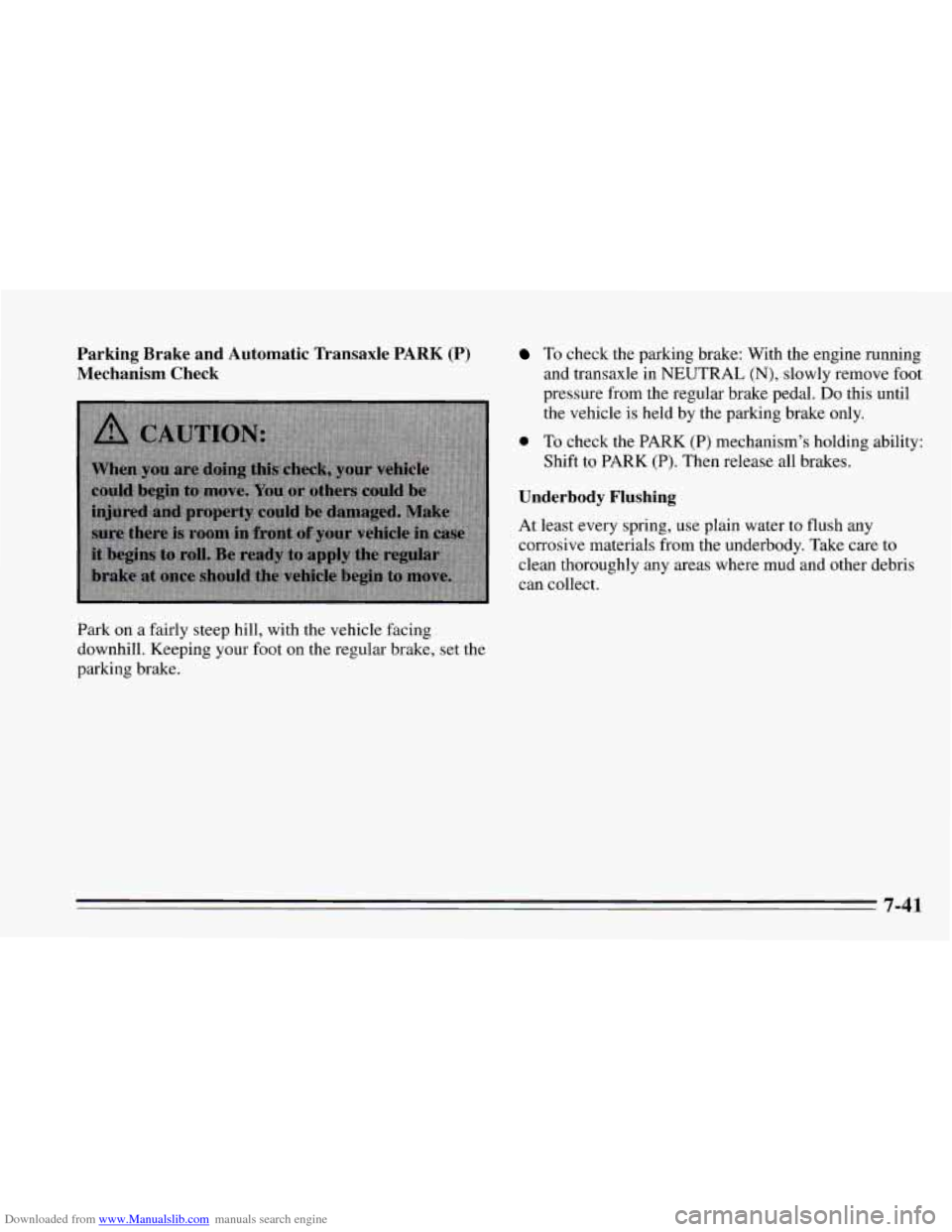
Downloaded from www.Manualslib.com manuals search engine Parking Brake and Automatic "ransaxle PARK (P)
Mechanism Check
Park on a fairly steep hill, with the vehicle facing
downhill. Keeping your foot on the regular brake, set the
parking brake.
To check the parking brake: With the engine running
and transaxle in NEUTRAL
(N), slowly remove foot
pressure from the regular brake pedal.
Do this until
the vehicle is held by the parking brake only.
0 To check the PARK (P) mechanism's holding ability:
Shift to
PARK (P). Then release all brakes.
Underbody Flushing
At least every spring, use plain water to flush any
corrosive materials from the underbody. Take care to
clean thoroughly any areas where mud and other debris
can collect.
7-41
Page 304 of 340
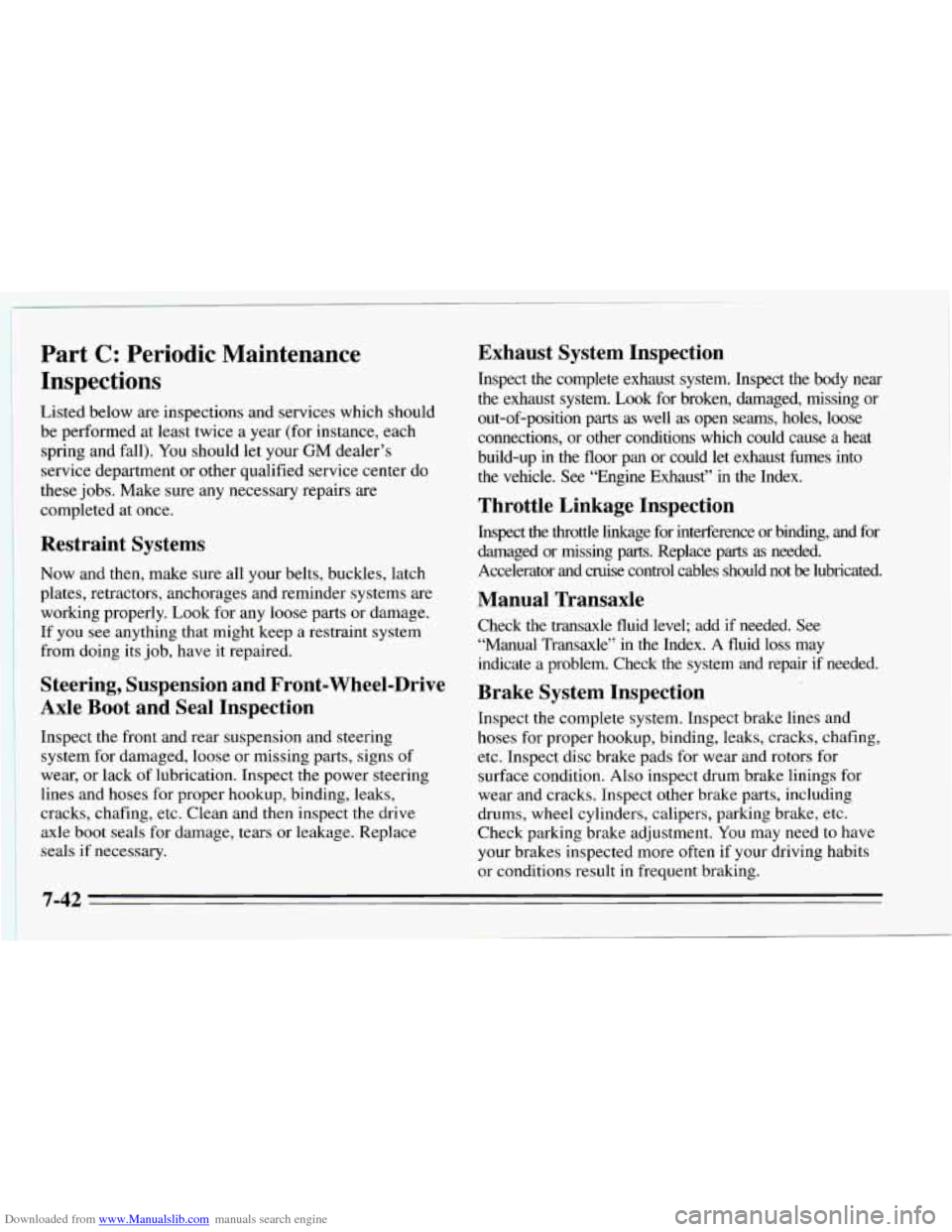
Downloaded from www.Manualslib.com manuals search engine Part C: Periodic Maintenance
Inspections
Listed below are inspections and services which should
be performed at least twice a year (for instance, each
spring and fall). You should let your
GM dealer’s
service department or other qualified service center do
these
jobs. Make sure any necessary repairs are
completed at once.
Restraint Systems
Now and then, make sure all your belts, buckles, latch
plates, retractors, anchorages and reminder systems are
working properly. Look for any loose parts or damage.
If you see anything that might keep a restraint system
from doing its job, have it repaired.
Steering, Suspension and Front-Wheel-Drive
Axle Boot and Seal Inspection
Inspect the front and rear suspension and steering
system for damaged, loose or missing parts, signs
of
wear, or lack of lubrication. Inspect the power steering
lines and hoses for proper hookup, binding, leaks,
cracks, chafing, etc. Clean and then inspect the drive
axle boot seals for damage, tears or leakage. Replace
seals if necessary.
Exhaust System Inspection
Inspect the complete exhaust system. Inspect the body near
the exhaust system.
Look for broken, damaged, missing or
out-of-position
parts as well as open seams, holes, loose
connections, or other conditions which could cause a heat
build-up in the floor pan or could let exhaust fumes into
the vehicle. See “Engine Exhaust”
in the Index.
Throttle Linkage Inspection
Inspect the throttle linkage for interference or binding, and f\
or
damaged or missing parts. Replace parts
as needed.
Accelerator and cruise control cables should not
be lubricated.
Manual Transaxle
Check the transaxle fluid level; add if needed. See
“Manual Transaxle” in the Index.
A fluid loss may
indicate a problem. Check the system and repair
if needed.
Brake System Inspection
Inspect the complete system. Inspect brake lines and
hoses for proper hookup, binding, leaks, cracks, chafing,
etc. Inspect disc brake pads for wear and rotors for
surface condition.
Also inspect drum brake linings for
wear and cracks. Inspect other brake parts, including
drums, wheel cylinders, calipers, parking brake, etc.
Check parking brake adjustment.
You may need to have
your brakes inspected more often if your driving habits
or conditions result in frequent braking.
7-42
~
Page 305 of 340
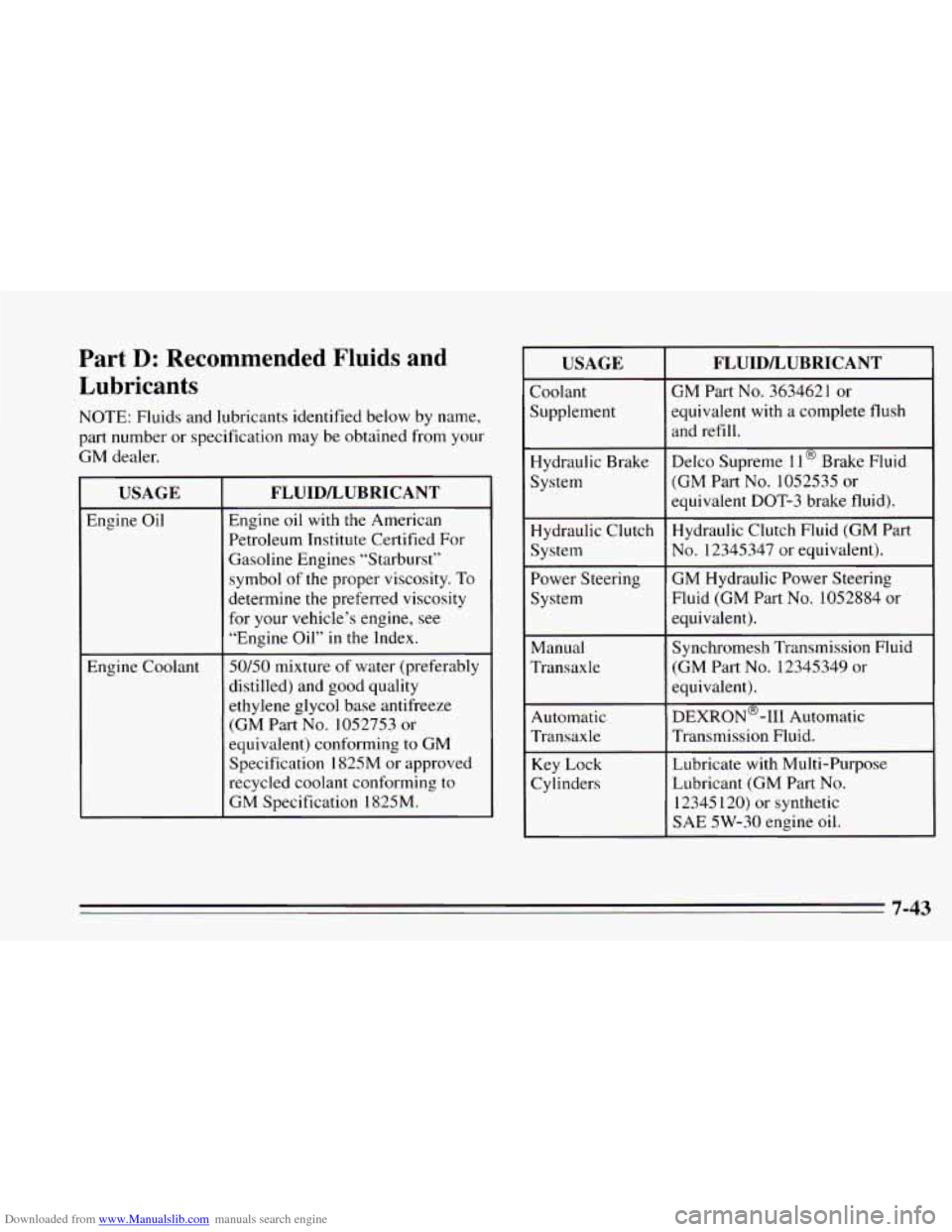
Downloaded from www.Manualslib.com manuals search engine Part D: Recommended Fluids and
Lubricants
NOTE: Fluids and lubricants identified below by name,
part number or specification may be obtained from your
GM dealer.
USAGE
Engine Oil
Engine Coolant
FLUIDLUBRICANT
Engine oil with the American
Petroleum Institute Certified For
Gasoline Engines “Starburst”
symbol
of the proper viscosity. To
determine
the preferred viscosity
for your vehicle’s engine, see
“Engine Oil”
in the Index.
50/50 mixture of water (preferably
distilled) and good quality
ethylene glycol base antifreeze
(GM Part No. 1052753 or
equivalent) conforming
to GM
Specification 1825M or approved
recycled coolant conforming to
GM Specification
1825M.
USAGE FLUIDLUBRICANT
Coolant
Supplement GM Part No. 3634621 or
(GM Part No. 1052535 or
System Delco Supreme
11 @ Brake
Fluid
Hydraulic Brake equivalent
with
a complete flush
Hydraulic Clutch Hydraulic Clutch Fluid (GM
Part
System No. 12345347 or equivalent).
Power Steering
GM Hydraulic Power Steering
System Fluid
(GM Part No. 1052884 or
equivalent). and refill.
~~
equivalent DOT-3 brake fluid).
Manual (GM Part
No. 12345349 or
Transaxle Synchromesh
Transmission Fluid
DEXRON@-111 Automatic
Automatic
Transaxle Transmission Fluid.
Key Lock Lubricate with Multi-Purpose
Cylinders Lubricant
(GM Part
No.
12345 120) or synthetic
SAE
5W-30 engine oil.
equivalent).
7-43
Page 306 of 340
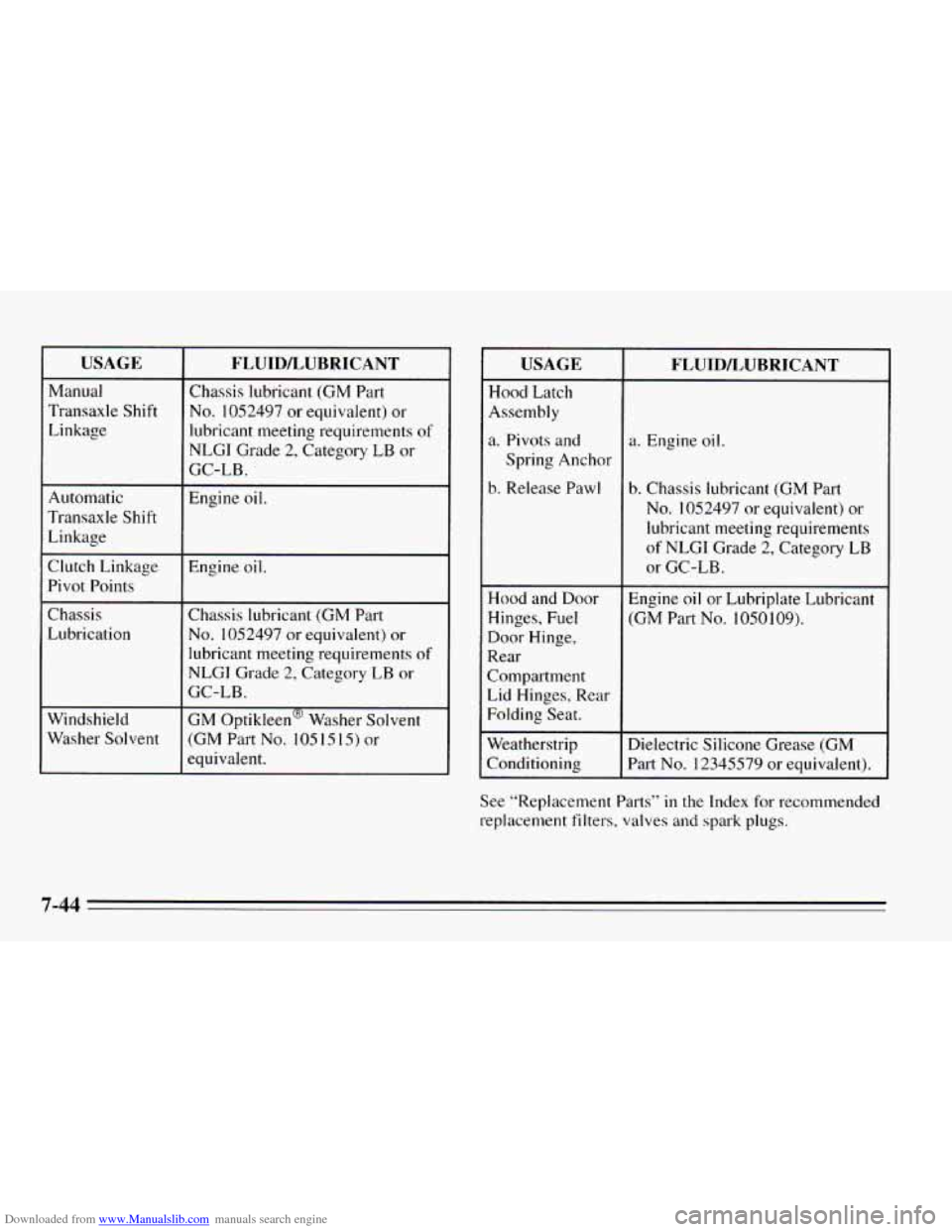
Downloaded from www.Manualslib.com manuals search engine USAGE
Manual
Transaxle Shift Linkage
Automatic
Transaxle Shift Linkage
Clutch Linkage
Pivot Points
Chassis
Lubrication
Windshield
Washer Solvent
FLUIDLUBRICANT
Chassis lubricant (GM Part
No. 1052497 or equivalent) or
lubricant meeting requirements
of
NLGI Grade 2, Category LB or
Engine oil. GC-LB.
Engine oil.
~~
Chassis lubricant (GM Part
No. 1052497 or equivalent) or
lubricant meeting requirements
of
NLGI Grade 2, Category LB or
GC-LB.
GM Optikleen@ Washer Solvent
(GM Part No. 105 15 15) or
equivalent.
USAGE
Hood Latch
Assembly
a. Pivots and
Spring Anchor
b. Release Pawl
1 .,,od and Door
Hinges, Fuel
Door Hinge,
Rear
Compartment
Lid Hinges, Rear
Folding Seat.
Weatherstrip
Conditioning
FLUID/IAJBRTCANT
a. Engine oil.
b. Chassis lubricant (GM Part
No. I052497 or equivalent) or
lubricant meeting requirements
of NLGI Grade 2, Category LB
or GC-LB.
Engine
oil or Lubriplate Lubricant
(GM Part
No. lOSOl09).
Dielectric Silicone Grease (GM
Part
No. 12345579 or equivalent).
See “Replacement Parts” in the Index for recommended
replacement filters, valves and spark
plugs.
7-44
Page 307 of 340
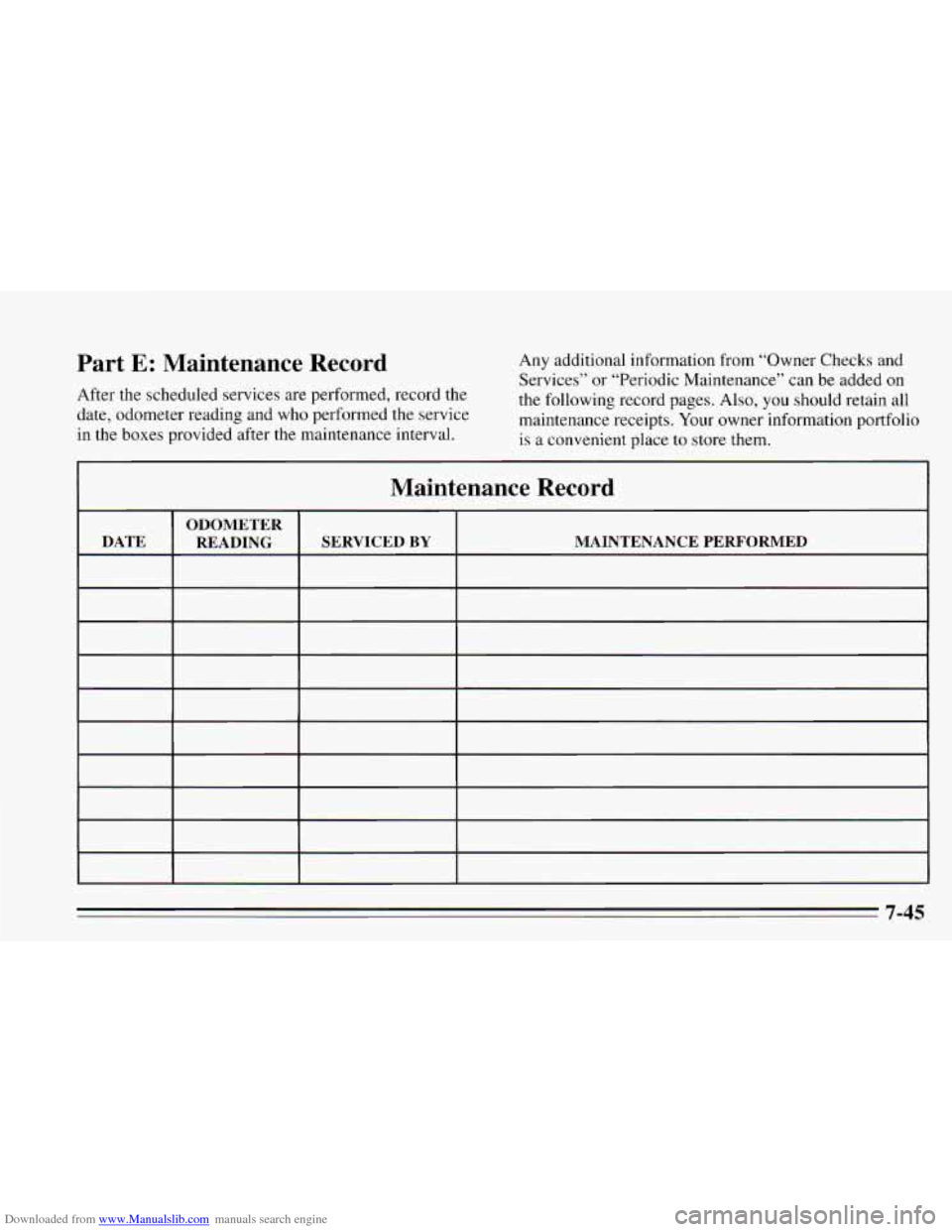
Downloaded from www.Manualslib.com manuals search engine Part E: Maintenance Record
After the scheduled services are performed, record the
date, odometer reading and who performed the service
in the boxes provided after the maintenance interval. Any
additional information from “Owner Checks and
Services” or “Periodic Maintenance” can be added on
the following record pages. Also, you should retain all
maintenance receipts. Your owner information portfolio
is
a convenient place to store them.
7-45
Page 308 of 340
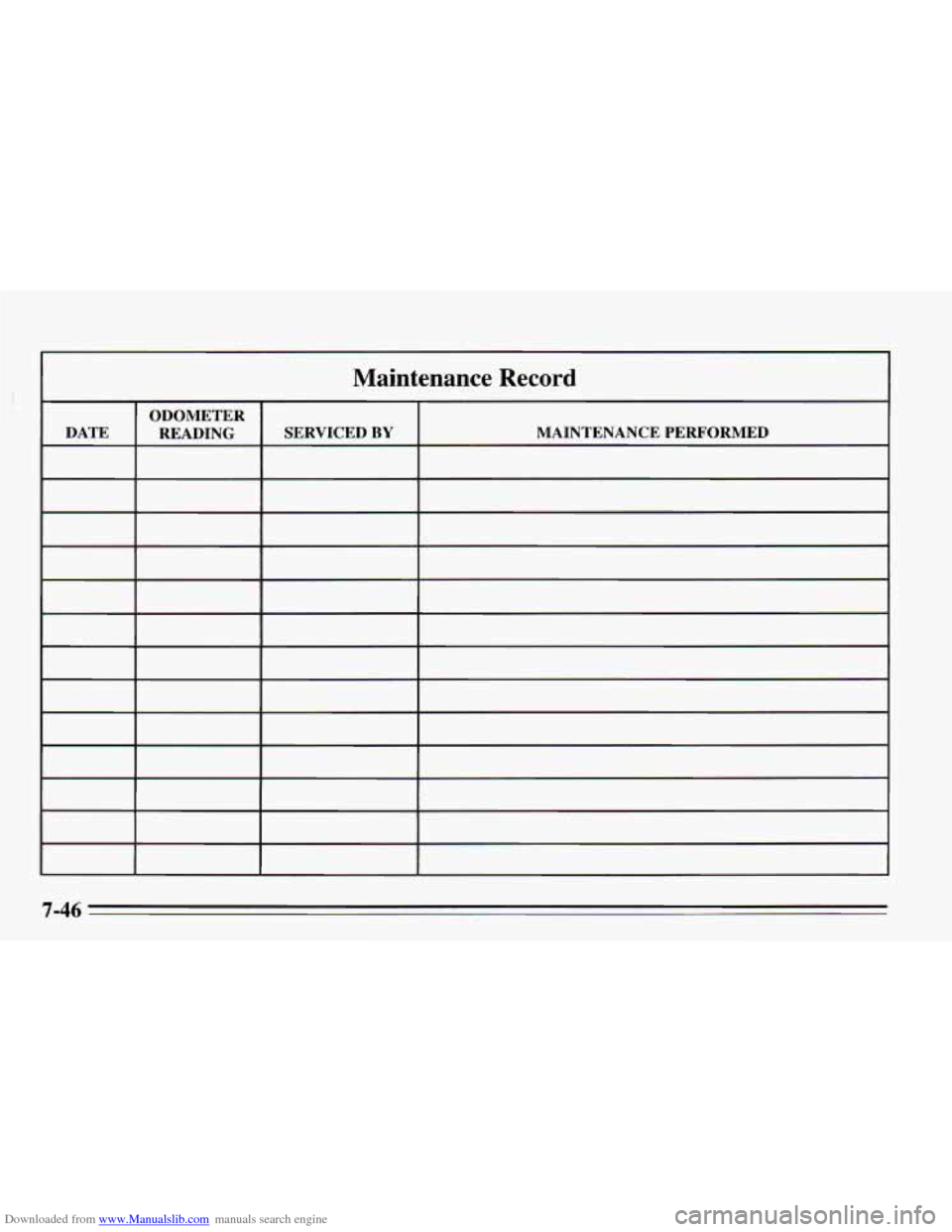
Downloaded from www.Manualslib.com manuals search engine Maintenance Record
ODOMETER
DATE MAINTENANCE PERFORMED
SERVICED
BY READING
7-46
Page 309 of 340
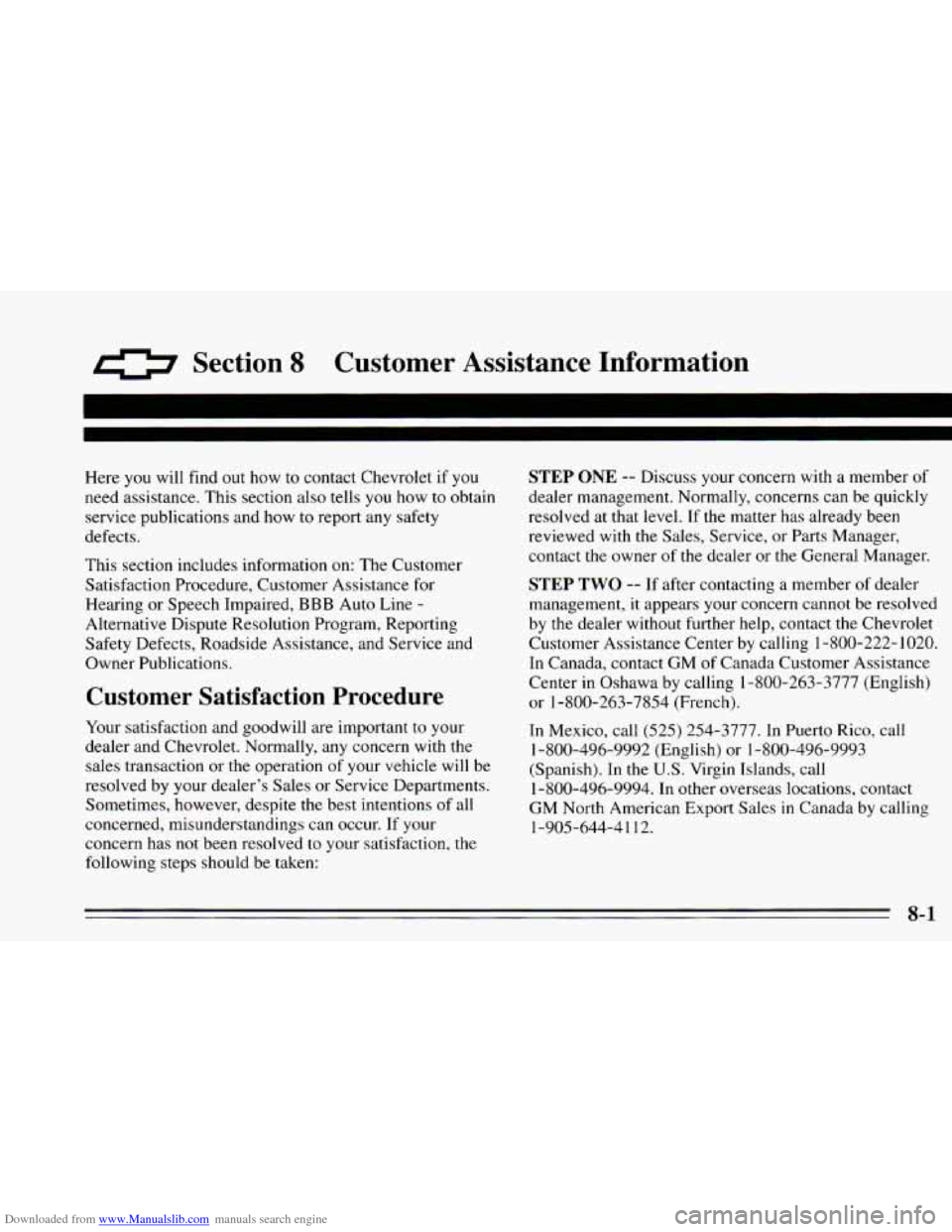
Downloaded from www.Manualslib.com manuals search engine 0 Section 8 Customer Assistance Information
Here you will find out how to contact Chevrolet if you
need assistance. This section also tells
you how to obtain
service publications and how to report any safety
defects.
This section includes information on: The Customer
Satisfaction Procedure, Customer Assistance for
Hearing or Speech Impaired,
BBB Auto Line -
Alternative Dispute Resolution Program, Reporting
Safety Defects, Roadside Assistance, and Service and
Owner Publications.
Customer Satisfaction Procedure
Your satisfaction and goodwill are important to your
dealer and Chevrolet. Normally, any concern with the
sales transaction or the operation
of your vehicle will be
resolved by your dealer’s Sales or Service Departments.
Sometimes, however, despite the best intentions of all
concerned, misunderstandings can occur. If your
concern has not been resolved to your satisfaction, the
following steps should be taken:
STEP ONE -- Discuss your concern with a member of
dealer management. Normally, concerns can be quickly
resolved at that level. If the matter has already been
reviewed with
the Sales, Service, or Parts Manager,
contact the owner of the dealer or the General Manager.
STEP TWO -- If after contacting a member of dealer
management, it appears your concern cannot be resolved
by the dealer without further help, contact the Chevrolet
Customer Assistance Center by calling
1 -800-222- 1020.
In Canada, contact GM of Canada Customer Assistance
Center
in Oshawa by calling 1-800-263-3777 (English)
or 1-800-263-7854 (French).
In Mexico, call (525) 254-3777. In Puerto Rico, call
1-800-494-9992 (English) or 1-800-496-9993
(Spanish). In the
U.S. Virgin Islands, call
1-800-496-9994. In other overseas locations, contact
GM North American Export Sales in Canada by calling
1-905-644-4
1 12.
Page 310 of 340
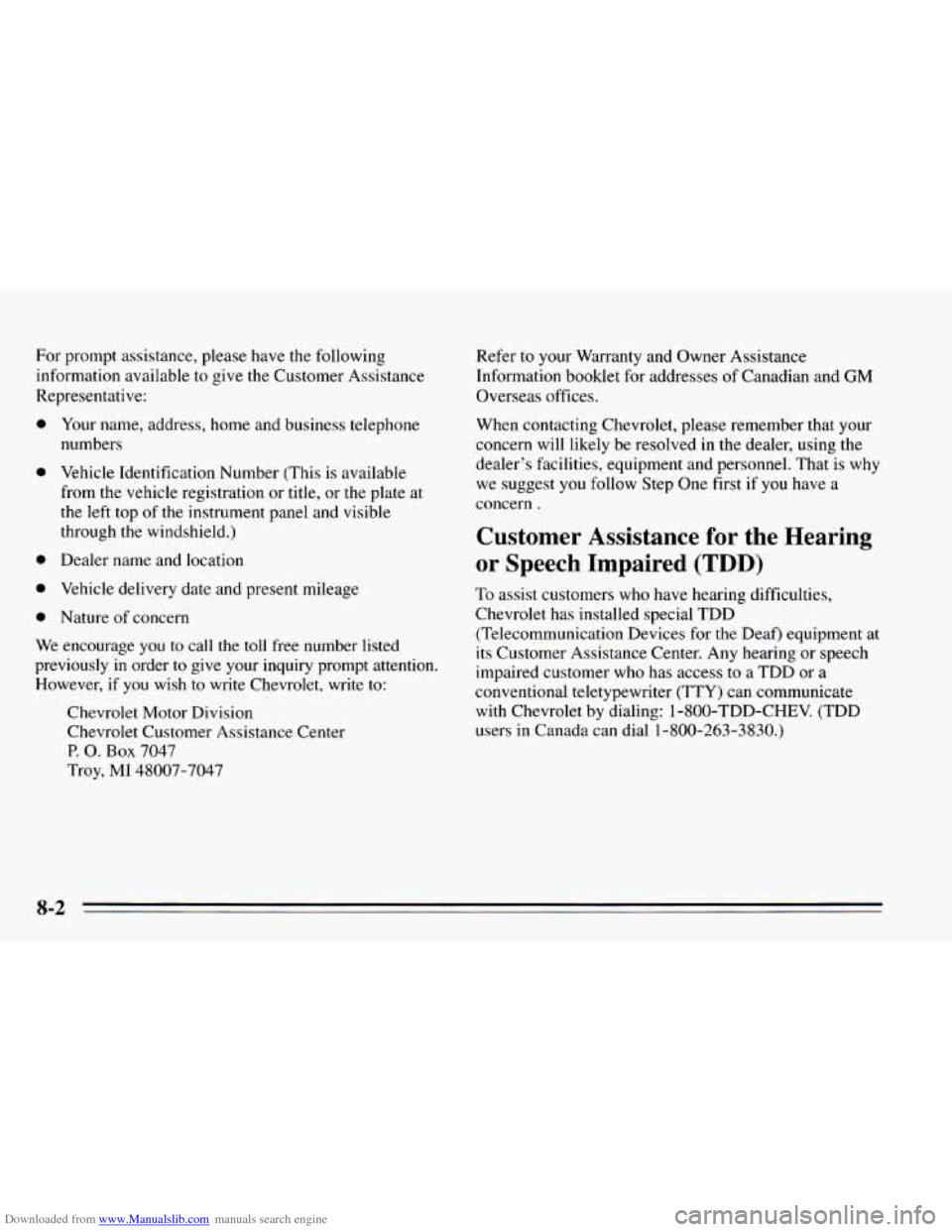
Downloaded from www.Manualslib.com manuals search engine For prompt assistance, please have the following
information available to give
the Customer Assistance
Representative:
0
0
0
0
0
Your name, address, home and business telephone
numbers
Vehicle Identification Number (This is available
from the vehicle registration or title, or the plate at
the left top of the instrument panel and visible
through the windshield.)
Dealer name
and location
Vehicle delivery date and present mileage
Nature of concern
We encourage you to call the toll free number listed
previously
in order to give your inquiry prompt attention.
However,
if you wish to write Chevrolet, write to:
Chevrolet Motor Division
Chevrolet Customer Assistance Center
P. 0. Box 7047
Troy,
MI 48007-7047 Refer
to your Warranty and Owner Assistance
Information booklet for addresses of Canadian and
GM
Overseas offices.
When contacting Chevrolet, please remember that your
concern will likely be resolved in the dealer, using the
dealer’s facilities, equipment and personnel. That is why
we suggest you follow Step One first if you have
a
concern .
Customer Assistance for the Hearing
or Speech Impaired
(TDD)
To assist customers who have hearing difficulties,
Chevrolet has installed special TDD
(Telecommunication Devices
for the Deaf) equipment at
its Customer Assistance Center.
Any hearing or speech
impaired customer who has access to a TDD or a
conventional teletypewriter (TTY) can communicate
with Chevrolet by dialing: 1 -800-TDD-CHEV. (TDD
users
in Canada can dial 1-800-263-3830.)
8-2